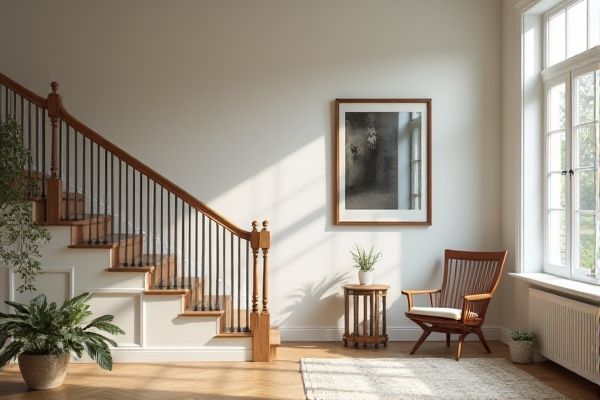
Gallery rails offer a sleek, minimalist design ideal for showcasing art with unobtrusive support, while plate rails provide a sturdy ledge perfect for displaying heavier plates or decorative items without wall damage. To discover which option best suits your space and style, continue reading the detailed comparison in this article.
Table of Comparison
| Feature | Gallery Rail | Plate Rail |
|---|---|---|
| Purpose | Used for displaying artwork securely in museums and galleries | Supports shelving, panel mounting, or hanging items on walls |
| Material | Typically aluminum or steel with a smooth finish | Often made of wood or metal, designed for structural support |
| Design | Wall-mounted rail with hooks or wires for adjustable picture hanging | Flat horizontal rail fixed on walls for supporting plates or shelves |
| Load Capacity | Supports lightweight to medium-weight artwork safely | Supports heavier loads depending on rail and wall type |
| Installation | Mounted at eye level, allowing flexible arrangement | Installed firmly on walls, often near countertops or shelving areas |
| Use Cases | Museums, art galleries, residential art display | Kitchens, display cabinets, retail shelving |
Introduction to Gallery Rail and Plate Rail
Gallery rails are raised, often decorative edges installed on shelves or trays to prevent items from falling, commonly used in kitchens and display cabinets. Plate rails are narrow ledges specifically designed to hold and showcase plates upright on walls or shelves, serving both functional and aesthetic purposes. Understanding the distinctions between gallery rails and plate rails can help you choose the best option for displaying or securing your items effectively.
Historical Background of Gallery Rails and Plate Rails
Gallery rails originated in medieval European architecture, designed as protective barriers on balconies or staircases to prevent objects from falling, while plate rails evolved later during the 18th century as ornamental ledges for displaying decorative plates and artwork. The historical use of gallery rails highlights their functional purpose in castles and grand homes, contrasting with the more aesthetic and showroom-like role of plate rails in Georgian and Victorian interiors. Understanding this evolution helps you appreciate the practical and decorative significance these two rail types bring to architectural design.
Design Differences: Gallery Rail vs Plate Rail
Gallery rails feature a raised, often ornate edge designed to prevent items from falling off shelves, commonly found in traditional cabinetry and furniture. Plate rails are flat or slightly raised horizontal moldings mounted on walls primarily to display decorative plates and protect walls from chair backs. The design difference lies in functionality and form: gallery rails emphasize containment with their elevated barriers, while plate rails focus on aesthetic display with minimal protrusion.
Functional Purposes of Gallery Rails
Gallery rails provide secure containment for plates and prevent items from slipping or falling, ideal for display or storage on shelves. Plate rails serve primarily as decorative moldings that support plates vertically for visual appeal and easy access. Your choice depends on whether functionality for safety or aesthetic presentation is the priority in your space.
Practical Uses of Plate Rails in Home Decor
Plate rails serve as elegant display ledges for decorative plates, artwork, and photos, adding both functionality and aesthetic appeal to living spaces. Their narrow design makes them ideal for creating visual interest on walls while saving floor space, often installed at chair rail height to protect walls and showcase collections. Unlike gallery rails that support hanging framed art, plate rails offer a versatile solution for easily swapping out decor without damaging walls.
Materials and Construction Comparisons
Gallery rails are typically constructed from durable metals like stainless steel or aluminum, providing strength and corrosion resistance ideal for marine environments. Plate rails are generally made from thick, solid aluminum plates offering superior structural support and rigidity, especially in heavy-duty applications. The choice between tubular gallery rails and plate rails often depends on the balance needed between weight, durability, and the specific functional demands of the vessel or installation.
Aesthetic Appeal: Styling Gallery and Plate Rails
Gallery rails feature raised edges that add a decorative, traditional touch to your shelves, enhancing the visual depth and sophistication of display areas. Plate rails offer a sleek, minimalist design that highlights your decorative plates or artwork without overpowering the overall decor. Choosing between gallery rail vs plate rail depends on whether you prefer ornate detailing or subtle framing to elevate your room's aesthetic appeal.
Installation Considerations for Each Rail Type
Gallery rails require wall anchoring with robust brackets to support heavy artwork, demanding precise stud alignment and professional tools for secure mounting. Plate rails, mounted near the ceiling, allow easier height adjustments and typically use fewer anchors, simplifying installation on drywall or plaster surfaces. Both systems necessitate careful measurement to ensure level alignment and accommodate the weight and dimensions of displayed pieces.
Maintenance and Care: Gallery Rail vs Plate Rail
Gallery rails require regular cleaning and occasional tightening of mounting brackets to maintain stability and appearance, often needing gentle dusting and lubrication for moving hooks. Plate rails, typically mounted flush to walls, demand less frequent adjustment but benefit from periodic dust removal and checks for paint chipping or wood warping to preserve finish integrity. Both systems benefit from using non-abrasive cleaners and avoiding moisture to prevent corrosion or damage, extending their functional lifespan.
Choosing the Right Rail for Your Space
Gallery rail offers a sleek, minimalistic look ideal for hanging multiple pieces in a dynamic layout, maximizing wall space without damage. Plate rail combines functionality and style, providing a sturdy ledge perfect for displaying heavier or larger artwork and decorative plates. Selecting between gallery rail and plate rail depends on your space's aesthetic and the type of art or items you wish to showcase.
 homyna.com
homyna.com